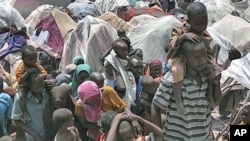The United Nations refugee agency reports tens of thousands of Somalis displaced by drought and famine are fleeing to Mogadishu in a desperate search of food, water, shelter and other assistance. The UNHCR says more than 100,000 people have arrived in the conflict-ridden capital over the last two months.
UNHCR figures show that over the past month alone, nearly 40,000 victims of drought and famine have fled to Mogadishu in search of help. The U.N. refugee agency reports the number of displaced is continuing to grow, with an average of 1,000 people converging on the city every day.
Refugee agency spokeswoman Vivian Tan said women and children are bearing the brunt of the emergency. She said this was brought home forcefully to a UNHCR official who just visited one of the larger camps for displaced people outside Mogadishu.
|
Definition of Famine: The word famine is a term that is not used lightly by humanitarian organizations. The United Nations describes a crisis as a famine only when the following conditions are met:
Current Famine:
|
She said the official saw alarming scenes of hordes of hungry, desperate people pushing and shoving to get whatever food was available.
“There was some aggression around the food distribution there. It was not our food distribution, but food donated by local charities," said Tan. "People were jostling. There were crowd rushes. There was even some looting. And, basically, our worry is that the weak and the more vulnerable people are getting missed because they cannot push ahead in front of the crowd. So, they are at risk of getting nothing.”
In a related event, the U.N. World Food Program is planning to begin the first of a series of airlifts to Somalia. The planes will each carry between 14 and 30 metric tons of food.
WFP spokeswoman Emilia Casella said the first plane leaving for Mogadishu will carry ready-to-eat therapeutic food for children who are severely malnourished. In the coming days, she said WFP hopes to begin airlifting desperately needed food to the southern Somali town of Gedo, which is on the border with Kenya and Ethiopia.
Casella said WFP works with local non-governmental organizations, as well as international and other U.N. agencies to distribute food to the hungry. She said this includes those who are living in areas that may be off limits to U.N. agencies.
“We will do whatever we can to get the food where it needs to go. And, this is an ongoing dialogue that we are having with all possible partners to get as far as we can to get in," said Casella. "The point is so that people do not leave their communities and make a harrowing and life-threatening trek to get to places where they can get food. Obviously, we need to get the food to where they are, rather then them having to risk their lives further to come out and receive it from us.”
The United Nations reports 3.7 million people, half of Somalia’s population, is in need of international assistance. The World Food Program says it is unable to reach 60 percent of these people with food.
This is because the Islamist al-Shabab militants have barred the agency from delivering aid to large areas in southern parts of this famine-stricken country. The group accuses WFP of undermining local farmers and having a political agenda.
Fourteen employees of the World Food Program have been killed in Somalia since 2008. WFP stopped delivering aid in al-Shabab-controlled areas in the south in January 2010, but continues to provide assistance to hundreds of thousands of needy people in accessible areas in southern, central and northern Somalia.
